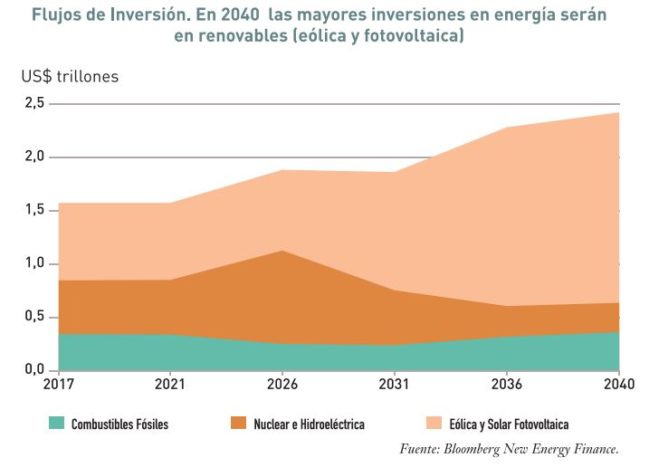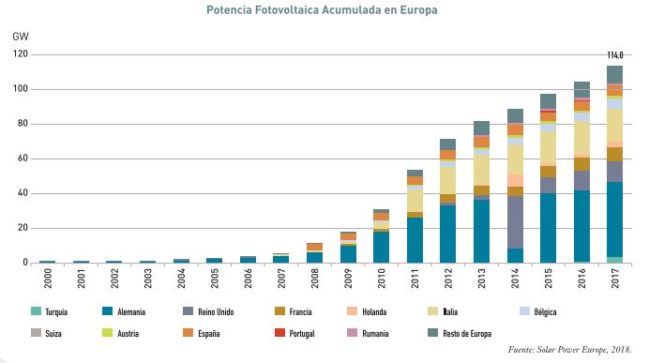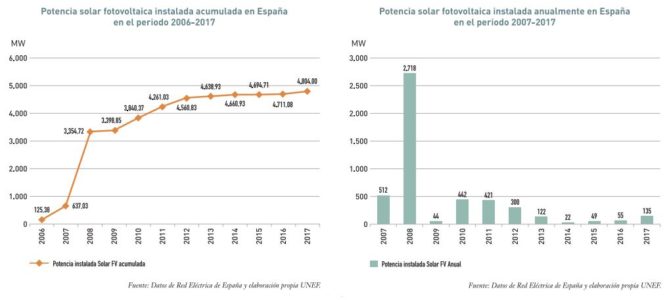-
Phone Number
-
Email Address
It seems that, in the near future, technologies based on Renewable energy such as solar and wind power have the opportunity to outperform traditional fossil fuels in terms of use. I mention photovoltaic solar energy and wind energy (See what is the role of wind energy in the world) because these seem to be more visible than other types of renewable energy. In reality, two realities are revealed: the revolution in the energy sector is driving change towards a renewable energy future and another, in which the overall transition is not moving with the speed necessary in many countries, although the prospects are positive.
This week, the Spanish Photovoltaic Union (UNEF) has published the annual report 2018 with the title of "2017: the beginning of a new era for the photovoltaic sector» and the true, rarely can we enjoy a report in Spanish that deals with the renewable energy sector in detail.
So we have taken the opportunity to extract the graphs and data more interesting visuals to understand the evolution current state of the energy sector both globally and in Europe and Spain .
Content menu:
In this new world scenario that undoubtedly benefits to the environment, the big loser will be the coal , whose generation potential will fall in all the countries.
It is estimated that by 2040 fossil fuels will only represent 50%, once the large power plants are finished their useful life and are replaced by less polluting sources and cheaper, such as renewables.

Therefore, we will be facing a market that is increasingly competitive based on a constant reduction of costs and with a large concentration of investment in energy renewable.

Bloomberg says renewable energy is becoming developing at a much higher rate than the experts predicted and that it will predictably eliminate coal as power source sooner than expected. The estimates are that solar energy already competes in terms of cost with the new coal plants in highly developed countries, like USA or Germany.

The growth of the photovoltaic sector worldwide worldwide in 2017 was more than 30% higher than in 2016 and it is expected that in 2018 and in the coming years the path of sustained and sustainable growth in the face of consolidation of already consolidated markets that continue to bet by a change in the energy model:

Globally, we can also cross-reference data from the report of Renewables 2018 Global Status Report issued by REN21.
If we consider the total photovoltaic power installed throughout Europe , almost nothing has changed in comparison with the previous year. Germany and Italy are leaders, they operate with more than half of the total power of Europe's photovoltaic solar power generation:

In the following map we can see the disparity that exists by European countries before the accumulated photovoltaic power (GW):

Although there are countries that will have to speed up these two last few years if they want to reach their commitments (Objective of 20% renewables in the energy mix in the year 2020), as is the case of Spain, France, the Netherlands or the United Kingdom. United among others.

In 2016, EU GHG emissions, including emissions from international aviation and emissions indirect CO2 emissions, decreased by 22.4% compared to 1990 levels. Thus, the EU is expected to exceed its Europe 2020 target to reduce greenhouse gas emissions greenhouse effect by 20% by 2020.

Wind energy has become the main source renewable energy in the Spanish economy from 2008 to the currently, reaching a peak, like that of 2017, of 56.7% of the total.

In 2017 there was a decrease in generation with energy renewable, especially due to the decrease in production hydraulics before a dry year plus an increase in generation photovoltaic, has caused the percentage of coverage with photovoltaic solar generation over the total renewable generation has increased from 7.9% up to 9.9% compared to 2016.

How can you test in the following graph, although Spain is one of the countries with the most hours of sunshine in all of Europe. Since 2012 there has been a stagnation in the generation of photovoltaic solar energy .

Although it is true, that the installed power in 2017, compared to 2016, it has doubled, up to 135 MW, still far from the levels seen in other countries of our environment.

And remember the article about what to do with all the panels plots when they end their useful life…And by communities:

The reality is that companies in the photovoltaic sector maintain their position in the face of the instability of the regulatory framework in Spain and some funds even sue Spain before the USA to pay for the renewable arbitrations that lost (HERE)… Will we have forceful changes from the administration?… Knowing that the photovoltaic sector generates more than 19,000 jobs in the country.
You can also read what happens if you live in a city that only uses renewable energy or how the different renewable energies with infographics.